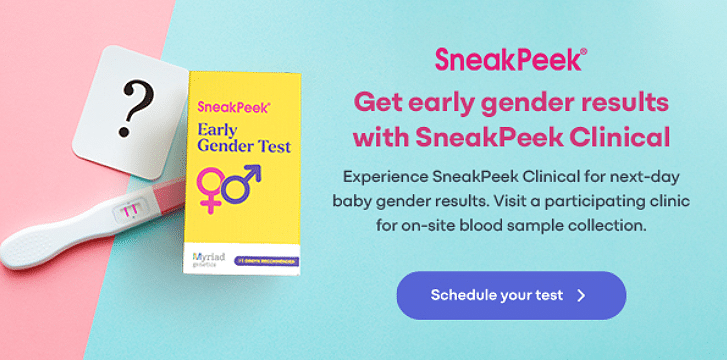Published on June 11th, 2025
Check out SneakPeek Gender Test to find out your baby’s gender as early as 6 weeks with over 99% accuracy!

You’re lying in bridge position at the end of your weekly yoga class when suddenly, a thought crosses your mind: Any chance this pose will boost my chances of conception?
Not to burst your bridge, but not exactly.
Fertility workouts are something of a myth. As far as the science goes, there’s no evidence to indicate that any particular workout can impact fertility or boost your chances of getting pregnant. However, there are certain kinds of exercise that could add more stress to your body and hormonal health—which means you may want to avoid them if you’re in the preconception stages.
Below, we explore the link between exercise and fertility so that you can protect your hormones while still getting your sweat on in that tender time before officially getting pregnant.
Fertility Workouts: Fact or Fiction?
While there’s no such thing as an exercise to get pregnant or a physical fitness program that directly boosts your ability to conceive, some people’s fertility could benefit from working out. Namely, individuals who are overweight or underweight may increase their odds of getting pregnant if they regularly engage in exercise.
Although weight is by no means an indicator of fertility, overweight and underweight people are more likely to have hormonal imbalances and other health issues that can make getting pregnant more difficult.
If you’re overweight, shedding fat may assist in your efforts to conceive. In particular, research indicates that two forms of exercise are most effective at shedding fat:
- Aerobic exercise
- Resistance training
If you’re underweight, strength training workouts that focus on building muscle (and therefore, putting on weight), may help raise your BMI (body mass index) and thus improve your fertility. You can also work with your healthcare provider to develop an eating plan that supplements your workout routine.
How Physical Exercise Impacts Fertility
If you’re wondering how to increase fertility and get pregnant, but you and aren’t sure what forms of exercise to engage in to support your journey, it’s helpful to know some of the ways exercise impacts your body—and by extension, your reproductive health.
Impact 1: Your Body Weight
As mentioned, weight can play a contributing role in your likelihood of conception if you’re at an extreme end of the spectrum.
When it comes to fertility, body weight interacts with your hormones and reproductive health in two key ways:
- Having excess body fat can result in higher levels of estrogen, which can interfere with your monthly hormonal cycles.
- Having too little body fat can suppress hormone cycles altogether, leading to skipped ovulation (anovulation) and missed periods (amenorrhea).
In other words, being overweight and underweight can both make it harder to get pregnant. That said, it’s best to consult with a healthcare provider before losing or gaining weight expressly for the purpose of your fertility status.
If you’re concerned about your body size, and you notice irregularity in your monthly cycles, your healthcare provider can run a complete health assessment during a preconception checkup. They may also recommend fertility testing.
Impact 2: Cardiovascular Health
Regular exercise plays a pivotal role in supporting cardiovascular well-being. When circulation runs smoothly and your cardiovascular health is in order, your body can better supply nutrients to your reproductive system.
Moreover, the cardiovascular system undergoes massive changes over those 9 months of pregnancy. The healthier it is before you conceive, the more readily it can adapt to shifts in blood pressure, blood volume, and the like.
Impact 3: Stress Levels
Physical activity is known to have marked benefits on stress levels. Active people feel the effects almost immediately in the form of endorphins, but exercise also helps even out stress over time.
So, does stress affect conception? While the relationship between fertility and stress remains unclear, studies do show that women who reduce their stress levels have higher success rates in getting pregnant. Exercise is just one simple, effective tool for doing so.
Impact 4: Sleep Quality
Sleep is foundational for overall health, both mental and physical. It’s thought that exercise has been shown to improve sleep quality by acting as a kind of stress pressure release valve, which may indirectly support fertility.
5 Workouts to Try When You’re Trying for a Baby
If you’re a cardio enthusiast or love vigorous exercise in general, don’t worry—plenty of people engage in high-intensity exercise when trying for a baby and are still able to conceive with success. Remember, there are many things that can make it harder to get pregnant and impact infertility, from not knowing when you ovulate to living with a chronic reproductive condition. Your doctor, along with fertility specialists, are your most reliable sources for determining what could be impeding your ability to get pregnant.
That said, if they recommend modifying your current exercise regimen, experimenting with lower-impact, lower-stress forms of movement could help! The following workouts are sure to raise your heart rate without putting too much unnecessary stress on your body—which is the name of the game when you’re trying to conceive.
#1 Walking
You read that right! Walking and other forms of low-impact cardio are ideal for boosting cardiovascular health without putting too much pressure on your body.
Brisk walks outside, on a treadmill, or related workouts like using an elliptical are all excellent, low-stress options for regular physical activity. Cycling is a higher-intensity option that’s also low-impact, which means you can reap the benefits of cardio without putting undue stress on your joints.
#2 Strength Training
Strength training is known to provide a host of benefits, including:
- Building and maintaining muscle mass
- Strengthening the joints
- Supporting bone health
- Managing weight
Even better? Low-intensity strength training is excellent for defending hormonal health—and you don’t necessarily need to head for the weight section of your gym to do it. Strength training can be performed using body weight alone, or using lightweight tools like resistance bands or free hand weights.
#3 Pilates
Pilates incorporates strength and resistance training with other areas of fitness like:
- Balance
- Flexibility
- Precision
- Body awareness (proprioception)
It also tends to emphasize core and pelvic floor strength, which could help prepare your body for pregnancy in the future. Like walking or cycling, Pilates tends to be lower impact and even mentally decompressing.
#4 Yoga
It’s a myth that yoga actively increases fertility, but it can nevertheless be an excellent fitness option if you’re preparing to conceive. Plus, certain fertility yoga poses may be helpful during pregnancy and in the postpartum stages by stretching muscles that bear the weight of your rapidly-changing body.
Postures to keep an eye out for include:
- Seated head-to-knee pose
- Reclined bound angle pose
- Legs-up-the-wall pose
- Garland pose (squat)
And if you enjoy pre-pregnancy yoga, you may love taking a prenatal yoga class during pregnancy!
#5 Swimming
Swimming is a relaxing, full-body form of exercise that’s uniquely easy on the joints. You’ll get some cardio while strengthening your respiratory system, and you may discover it’s tremendously calming to the nervous system.
For this reason, swimming is an excellent fertility workout to try if you struggle with irregular cycles and chronic stress. If swimming becomes your go-to workout, you’ll be happy to learn you can safely continue swimming while pregnant.
Key Guidelines for Working Out During the Preconception Stage
With a better grasp of what exercises are ideal pre-pregnancy, it’s also helpful to know how to get the most out of them. These suggestions can serve to support (rather than derail) your fertility journey as you discover what works for you:
- Try to stay consistent – If you’re adopting a regular workout routine—especially to shed fat—it’s important to aim for as much consistency as possible. Not only will this help you stay motivated, but it’s also gentler on your hormones and the most effective way to build strength over time.
- Make adequate time for recovery – Athletes and committed fitness enthusiasts know that adequate recovery time is a feature of exercise plans, not an afterthought. While getting at least 30 minutes of movement a day is encouraged, it’s equally important to dedicate time to letting your body recover. This allows you to replenish fluids, prioritize sleep, avoid overtraining your muscles and joints, and support your hormone health.
- Prioritize low-impact options and active recovery days – High-intensity exercise, or types of exercise in extreme climatic environments, may add undue stress to your body. For this reason, it’s best to prioritize lower-impact options before you conceive (and continue low-intensity exercises for pregnancy as well). Exercises like yoga and walking are also ideal for days when you need to recover but still want to get in some gentle movement.
If you’re trying to balance your need for physical activity with lowering stress levels, it might be helpful to create a new “relaxation routine” to complement your workout routine. In doing so, you can build a total-body-and-mind wellness regimen that works for your lifestyle and family plans.
Launch Your Pregnancy Journey with the SneakPeek® Test
When it comes to the preconception stage, creating an atmosphere of compassion and tenderness toward your body is critical—even if you’re trying to level it up in the fitness department!
For an even smoother ride into pregnancy, check out the at-home Early Gender Test from SneakPeek. With this simple-to-use test, future parents can learn their baby’s sex as early as 6 weeks into gestation with over 99% clinically proven accuracy.
More than 1 million parents (and counting) have used the SneakPeek test to reveal their future baby’s sex sooner than ever before. Find out why the SneakPeek test was recommended six-to-one among 100 OBGYNs surveyed by ordering your test kit today.
Editorial Policy
At SneakPeek, our commitment is to provide accurate, up-to-date, and reliable information to empower our readers. Our content is thoroughly researched, reviewed by medical experts, and fact-checked to ensure its credibility. We prioritize the well-being and education of our readers, and our editorial policy adheres to the highest standards of integrity and accuracy in all our articles.
This post has been reviewed for accuracy by:
Haley Milot, a highly skilled laboratory professional, currently serves as the Associate Director of Lab Operations at Gateway Genomics, the parent company of SneakPeek. Her extensive experience in laboratory management, spanning over seven years with Gateway Genomics, showcases her expertise in quality assurance, quality control, and the development of laboratory procedures. Haley's background includes pivotal roles in DNA extraction and purification, real-time qPCR, and specimen accessioning, underscoring her comprehensive understanding of laboratory operations and diagnostics. Her adeptness in managing complex laboratory functions and her deep knowledge of medical diagnostics make her a vital contributor to SneakPeek's innovative approach to prenatal testing.
Sources:
- National Library of Medicine. The effect of physical activity on fertility: a mini-review. https://pmc.ncbi.nlm.nih.gov/articles/PMC10310950/
- The Conversation. How does being overweight affect my fertility? https://theconversation.com/how-does-being-overweight-affect-my-fertility-95224
- AHA Journals. Cardiovascular Physiology of Pregnancy. https://www.ahajournals.org/doi/full/10.1161/CIRCULATIONAHA.114.009029
- Mayo Clinic. Exercise and stress: Get moving to manage stress. https://www.mayoclinic.org/healthy-lifestyle/stress-management/in-depth/exercise-and-stress/art-20044469
- National Library of Medicine. The relationship between stress and infertility. https://pubmed.ncbi.nlm.nih.gov/29946210/
- Cleveland Clinic. How Exercise Affects Your Sleep. https://health.clevelandclinic.org/how-exercise-affects-your-sleep
- Healthline. 5 Fat-Burning Low Impact Exercises That Won’t Kill Your Knees. https://www.healthline.com/health/fitness-exercise/low-impact-exercises
- Women’s Health. 8 Benefits of Strength Training That’ll Convince You To Try It. https://www.womenshealthmag.com/fitness/a34030549/strength-training-benefits/
- Healthline. Prenatal Yoga Poses for Every Trimester. https://www.healthline.com/health/fitness/prenatal-yoga-poses
- National Institute for Fitness and Sport. In Training, Consistency Is the Key to Your Fitness Goals. https://www.nifs.org/blog/in-training-consistency-is-the-key-to-your-fitness-goals
- What to Expect. Exercise When You’re Trying to Get Pregnant. https://www.whattoexpect.com/getting-pregnant/health-and-wellness/safeguard-your-health/exercise-before-pregnancy.aspx
- National Library of Medicine. Physical activity and fertility. https://pmc.ncbi.nlm.nih.gov/articles/PMC7614776/
- National Library of Medicine. The effect of physical activity on fertility: a mini-review. https://pmc.ncbi.nlm.nih.gov/articles/PMC10310950/
- Healthline. 16 Natural Ways to Boost Fertility. https://www.healthline.com/nutrition/16-fertility-tips-to-get-pregnant#exercise
- Better Health Channel. Weight, fertility and pregnancy health. https://www.betterhealth.vic.gov.au/health/conditionsandtreatments/weight-fertility-and-pregnancy-health








